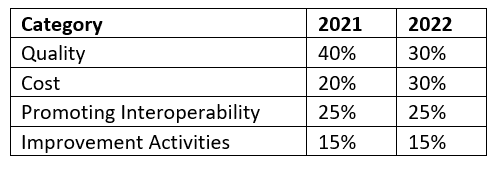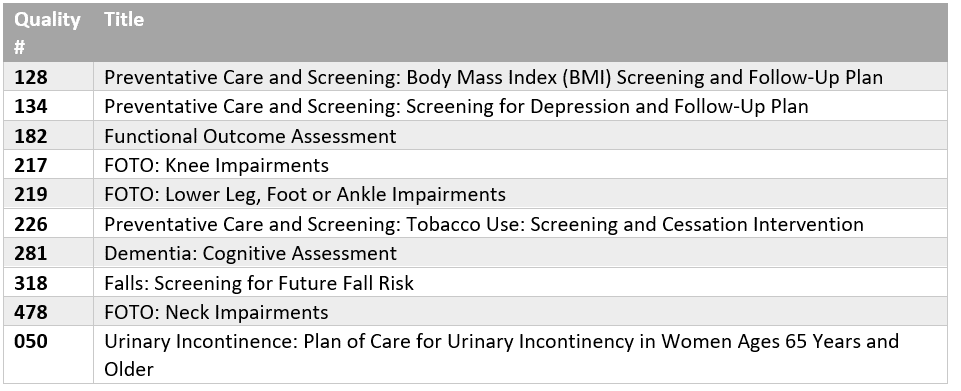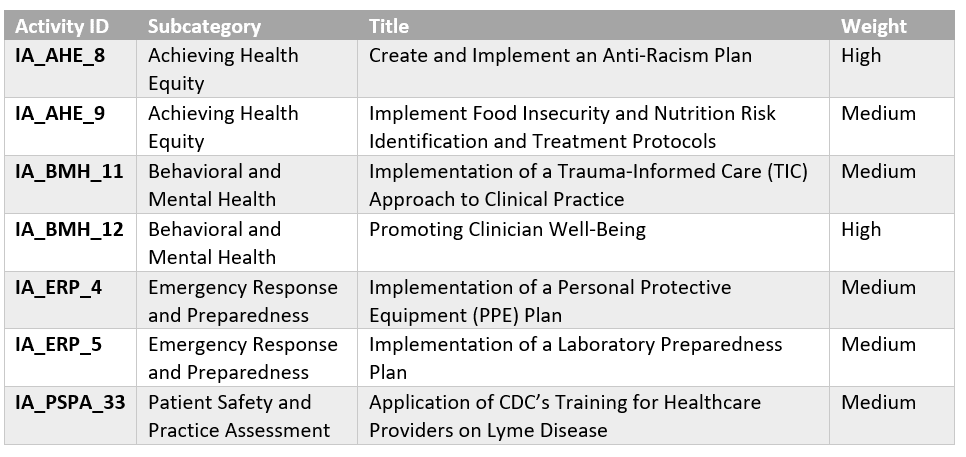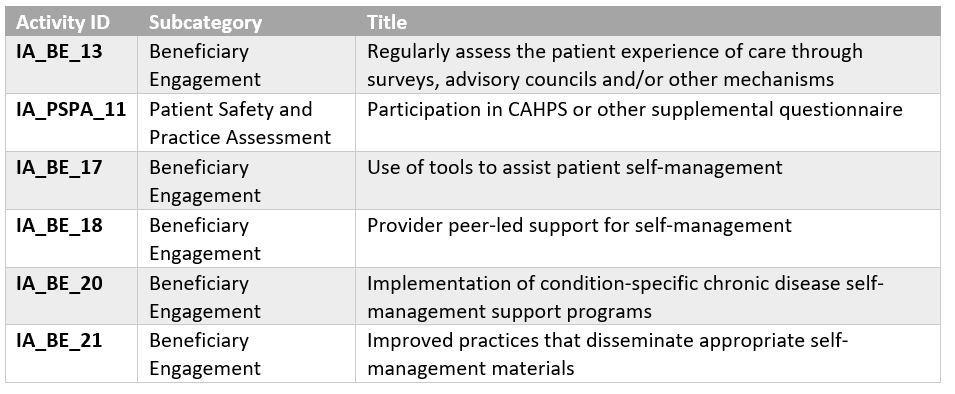January 27, 2022 | Jessica Zeff
3 Minute Read
Highlights From the 2022 Quality Payment Program (QPP) Final Rule
If you’re reading this, you’re likely to have attended our recent webinars with Ellen Strunk founder of Rehab Resources and Consulting, Inc. and Rick Gawenda of Gawenda Seminars and Consulting, clarifying the substantive changes from the 2022 MPFS & QPP Final Rules. And if you were not able to attend, no worries, you can find recordings of each of the webinars below – simply click on one of the links below. I strongly encourage anyone who would like to know more about the changes to this year’s MPFS & QPP final, to have a look at these informative webinars.
Rick Gawenda, 2022 CQ/CO Modifiers Update
Ellen Strunk, 2022 MPFS Final Rule
Ellen Strunk, 2022 MIPS Update
In case you’re wondering whether it’s worth the effort, it sure is! Let me take you through a sneak peek and run through some of the substantive changes included in the final rule.*
*Please note that what we’re providing to you here is a summary of the rules as we understand them. This summary is not intended to be a comprehensive review of the rule and should not be relied upon for determining how your organization should proceed. That said, we hope this review (along with our webinars) acts as a reliable resource for clarifying some of the complexities of the 2022 QPP Final Rule.
MIPS Eligible Clinicians
Clinical Social Workers and Certified Nurse Mid-Wives were added to the eligible clinician list for MIPS beginning with performance year 2022. Each clinician type will have an associated specialty set for quality measure reporting.
Performance Threshold
The proposed threshold for avoiding a penalty was finalized at 75 points for performance year 2022. This is an increase of 15 points from 2021.
The exceptional performance threshold was finalized at 89 points. The 2022 performance year will be the final year for the exceptional performance adjustment. The payment impact for 2024 is outlined in the table below:

Performance Category Weighting
Under statutory requirements, the categories for quality and cost are being weighted equally as of performance year 2022. For the traditional MIPS program, weighting of the four categories are:

Automatic reweighting will still be applied for PT, OT, SLP and Audiologists based on the “no Cost and no Promoting Interoperability” reweighting (Quality 85% and Improvement Activities 15%). Additional reweighting options also exist for small practices.
Complex Patient Bonus
The goals of the complex patient bonus are 1) to protect access to care for complex patients and provide them with excellent care; and 2) to avoid placing MIPS eligible clinicians who care for complex patients at a potential disadvantage while the completed studies are reviewed and researched.
For the 2021 performance period, the complex patient bonus will be doubled and subject to a 10-point cap. This bonus is added to the final MIPS score. For 2022, the calculation for the complex patient bonus will be modified and will be capped at 10 points.
In addition, MIPS eligible clinicians, groups, subgroups, virtual groups or APM entities must submit data for at least one MIPS performance category to receive the complex patient bonus points.
Quality Performance Category
Bonus points
End-to-end electronic reporting bonus points were removed. Additional bonus points for reporting more than one high priority or outcome measure was also removed.
Data Completeness
The data completeness threshold will be maintained at 70% for 2021 through 2023 performance years.
Case Minimum
The case minimum will remain at 20 cases for the 2022 performance year. If a case minimum is not met in 2022, MIPS eligible clinicians will earn 3-points; however, in 2023, zero points will be given if case minimums are not met. A small practice exception will remain for 2022 and 2023 that awards 3-points when a case minimum is not met.
Quality Measures
CMS has finalized 200 quality measures for 2022 reporting. This includes the removal of 13 quality measures and the addition of 4. Substantive changes were made to 87 of the quality measures for 2022.
Therapy – Quality Measure Specification Changes
Changes were made to the following commonly used quality measures for 2022. You should review each of the quality measures you are reporting on.

Therapy – Specialty Set Changes
The PT/OT Specialty Measure Set was updated to remove measure 154: Falls: Risk Assessment. This measure was also removed from the MIPS program for 2022 and future years due to being at the end of the topped-out life cycle. Clinicians can continue to report on measure 155: Falls: Plan of Care.
Measure 050: Urinary Incontinence: Plan of Care for Urinary Incontinence in Women Ages 65 Years and Older was added to the PT/OT Specialty Measure Set for 2022.
There were no changes to the Speech Language Pathology Specialty Measure set for 2022.
Improvement Activities Performance Category
No changes to scoring of improvement activities were made in this final rule. Scoring for Improvement Activities will remain at 20 points for medium weighted and 40 points for high. CMS added 7 new improvement activities, removed 6, and modified 15 improvement activities for 2022.
New improvement activities for 2022:

Removed improvement activities removed for 2022:

One of the modified improvement activities for 2022 includes IA_BE_6, “Regularly Assess Patient Experience of Care and Follow Up on Findings”. You should review the criteria for validation and documentation for this, and any others you use, to determine if you need modify your data collection and follow-up for this activity.
Cost Performance Category
The cost performance category was reweighted to 0% for 2020 performance data following concerns about data validity during the COVID19 PHE. Future reweighting may occur.
Promoting Interoperability Category
The weights for the Promoting Interoperability (25%) and Improvement Activities (15%) categories will remain the same as 2021. CMS aims to move fully to digital quality measures (dQMs) for quality reporting using Fast Healthcare Interoperability Resources (FHIR) by 2025.
MIPS Value Pathways (MVPs)
CMS has adopted substantial policy changes to traditional MIPS reporting in 2022 and future years. The traditional MIPS program included two payment tracks clinicians could choose from: MIPS and Advanced Alternative Payment Models (APMs). CMS is working to transform this traditional MIPS program with MVPs.
MVP reporting will be voluntary for performance years 2023-2027. Mandatory reporting is anticipated in the future and is planned to coincide with the sunsetting of traditional MIPS. Transition to MVPs will be highly dependent upon a movement toward use of both digital quality measures (dQMs) and Fast Healthcare Interoperability Resources (FHIR) to allow standardization and interoperability in quality reporting programs.
MVPs Approved for 2023
- Advancing Rheumatology Patient Care
- Coordinating Stroke Care to Promote Prevention and Cultivate Positive Outcomes
- Advancing Care for Heart Disease
- Optimizing Chronic Disease Management
- Adopting Best Practices and Promoting Patient Safety within Emergency Medicine
- Improving Care for Lower Extremity Joint Repair
- Support of Positive Experiences with Anesthesia





